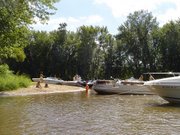 When we purchased our current boat in June of 2007 it had marine radar already installed.
When we purchased our current boat in June of 2007 it had marine radar already installed.I wanted the radar to be more then a dash mounted device to impress guests. My goal was to use radar as a tool to aid in collision avoidance specifically during in poor visibility conditions. This would include small, unlit fishing boats that are common in our area.
I significantly underestimated how difficult it was to learn how to use this tool.
I had experience with GPS/charplotters. When I first got my GPS chartplotter I was using it and understanding what was on the screen minutes after powering it up for the first time. I had to read the manual to know how to make waypoints, tracks and routes, and change the screen so it was showing what I wanted but all totaled this took a couple of hours.
I found learning how to use Radar to be challenging and at times frustrating. A poor manual that was not written for beginners and having no one with experience that could answer questions added to the challenge.
Using radar and understanding what I was seeing on the screen and knowing how to make the proper adjustment to get the radar to perform took perseverance, practice and patience.
I made a commitment to use and understand this device.
Over the past 2+ months using radar I have just over 70 hours of experience using radar and many hours reading the manual and reading a marine radar tutorial. What I do is I use it, go back and read then use it more.
I use the radar all the time, even during the day when there is clear visibility so I gain experience with Radar and become familiar with what various targets look like on the screen when I can see them with my eyes. I identify targets on the screen then try to find them with my eyes.
I am just beginning to be able to look at the screen and say to a passenger “There are two birds flying directly behind the boat, about 50 feet behind us.”
When first installed there are initial settings that must be performed for the radar to operate properly. Since the initial settings were not set on our radar I don’t think the previous owners depended on the radar. Adjustments like the heading were way off. The heading adjustment is needed so what is directly in front of you is straight up on the display. The tuning, timing and clutter settings were also far out of proper adjustment. At the beginning nothing on the screen made sense. Now that I have some experience using radar and have gone thru the manual and the various initial setup adjustments I can tell when things are off. I’ve even went so far as to mess things up on purpose to gain experience at properly resetting the radar.
When I am on a lake and at least a mile off shore or more I set the range to 1.5 miles. This gives you a radius of 1.5 miles. The total screen covers 3 miles. I will zoom in to .25 miles when on a narrow river.
The first thing you may ask is “Why do you even have the radar running when you are boating on a narrow river?” Well, if you are in a wake zone you can see a faster boat coming up behind you as you are facing forward. Being aware of a boat that is going to pass you increases your safety. It prevents you from being startled or making a potentially dangerous course adjustment. A second reason to keep the radar on and zoomed in would be to gain experience.
I keep the range rings on. This means there are several circles on the screen, one inside the other, at a set calibration. Say you are at the 1.5 mile range setting and have 3 rings. A target that is at the outermost ring is 1.5 miles away. A target that is at the 2nd ring is 1 mile away, and so on. This allows you to estimate how far away a target is from you.
The better you adjust the various settings the better you can reduce clutter yet still see small targets. At first I set every adjustment I could to ‘auto adjusts.’ Today I keep all auto adjust settings off except tuning. Auto adjusting settings such as rain clutter, sea clutter, and tuning make using the radar easier however I have found I can adjust the unit better then it can.
If you are using radar for collision avoidance like me, you want to see that small flat bottom skiff with no lights at night. I find if I leave the settings on auto-adjust I loose small objects or gain so much clutter I can’t differentiate an actual target from interference.
I’m confident at adjusting the STC (sea clutter), FTC (rain clutter) and gain and can re-adjust these on the fly as sea and weather conditions change or when my location dictates that I need to adjust the range setting.
I’m getting better but it takes me time to get things adjusted correctly. Also, I am committed to continue my radar education and experience.
I’m glad to have radar and still consider myself to be a novice on the inclining part of the learning curve. However I am past the maddening steep part of the curve.
